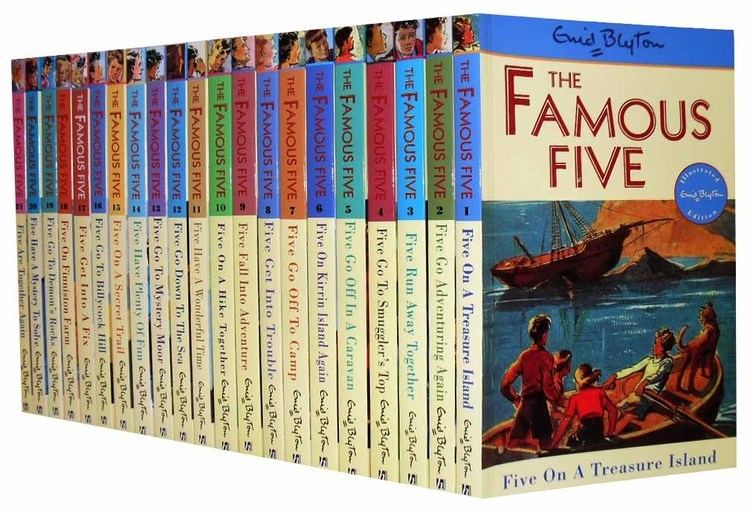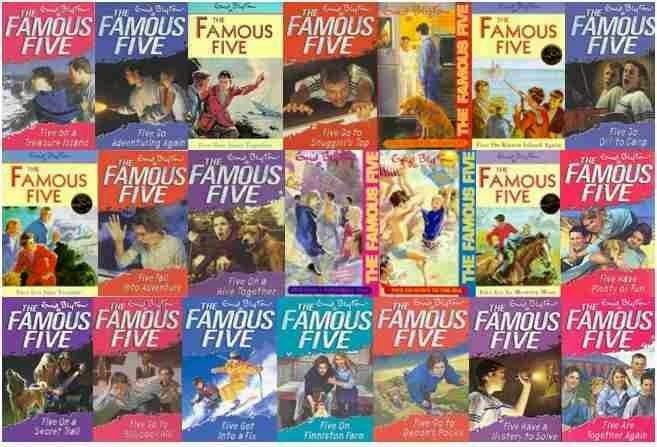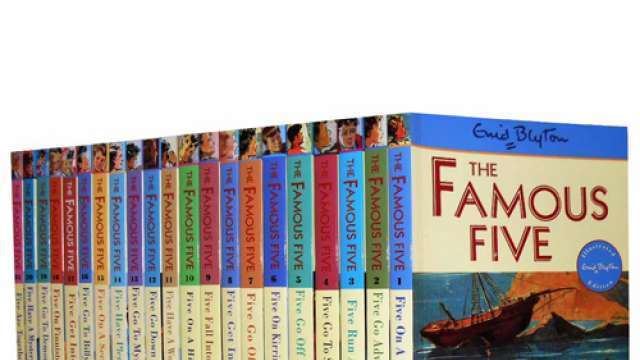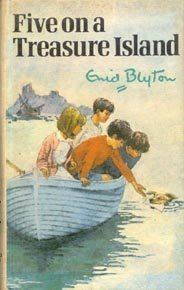Language English No. of books 21 Number of books 21 Country United Kingdom | Published 1942—62 Publisher Hodder & Stoughton Dog Timmy | |
 | ||
Media type Print (hardback & paperback) Genres Children's literature, Mystery | ||
The Famous Five is the name of a series of children's adventure novels written by English author Enid Blyton. The first book, Five on a Treasure Island, was published in 1942. The novels feature the adventures of a group of young children – Julian, Dick, Anne and Georgina (George) – and their dog Timmy.
Contents
- The five
- Close friends
- Family
- Critical discussion
- Floating timeline
- Films
- 197879 series
- 1995 series
- Famous 5 On the Case
- Audio dramas
- Theatre
- Gamebooks
- Video games
- Comics
- Parodies
- References

The stories take place in the children's school holidays after they have returned from their respective boarding schools. Each time they meet they get caught up in an adventure, often involving criminals or lost treasure. Sometimes the scene is set close to George's family home at Kirrin Cottage in Dorset, such as the picturesque Kirrin Island, owned by George and her family in Kirrin Bay. George's own home and various other houses the children visit or stay in are hundreds of years old and often contain secret passages or smugglers' tunnels.

In some books the children go camping in the countryside, on a hike or holiday together elsewhere. The settings, however, are almost always rural and enable the children to discover the simple joys of cottages, islands, the English and Welsh countryside and sea shores, as well as an outdoor life of picnics, lemonade, bicycle trips and swimming.

Blyton intended to write only six or eight books in the series, but owing to their high sales and immense commercial success she went on to write twenty-one full-length Famous Five novels, as well as a number of other series in similar style following groups of children discovering crime on holiday in the countryside. By the end of 1953 more than six million copies had been sold. Today, more than two million copies of the books are sold each year, making them one of the biggest-selling series for children ever written, with sales totalling over a hundred million. All the novels have been adapted for television, and several have been adapted as films in various countries.

Blyton's publisher, Hodder & Stoughton, first used the term "The Famous Five" in 1951, after nine books in the series had been published. Before this, the series was referred to as "The 'Fives' Books".

The five
Close friends
Family
Critical discussion
Blyton was a nature writer early in her career, and the books are strongly atmospheric, with a detailed but idealised presentation of the rural southern English landscape. The books present children exploring this landscape without parental supervision as natural and normal. Pete Cash of the English Association has noted that the children "are allowed to go off on their own to an extent that today would contravene the Child Protection Act (1999) and interest Social Services."
The books are written in a nostalgic style even for the time they were written, avoiding reference to specific political events or technological developments. Cash noted that the characters do not watch television apart from one appearance in 1947, or even make much use of radios despite George's father's work presumably involving advanced technology.
The books have been criticised for being repetitive, with repeated use of stock elements such as obnoxious, unfriendly people who turn out to be criminals and the discovery of a secret passageway. Blyton wrote rapidly and could finish a book in a week, which meant that unlike other book series of the period, such as Nancy Drew, she was able to maintain control of her creations and write all the stories in a series herself.
The treatment of girls in the books provides a contrast, with Anne, the youngest and most fragile character, an opposite to the brash and headstrong George.
Floating timeline
The seemingly perpetual youth of the Famous Five, who experience a world of apparently endless holidays while not ageing significantly, is known as a floating timeline. Floating timelines allow for an episodic series with no defined end-point, but at the expense of losing a sense of the characters growing up. J. K. Rowling commented of her Harry Potter series that she deliberately intended to avoid this in her writing: "in book four the hormones are going to kick in – I don't want him stuck in a state of permanent pre-pubescence like poor Julian in the Famous Five!"
Films
There exist two Children's Film Foundation films of the Famous Five books: Five on a Treasure Island, made in 1957, and Five Have a Mystery to Solve, produced in 1964.
Two of the Famous Five stories by Enid Blyton have been filmed by Danish director Katrine Hedman. The cast consisted of Danish actors and were originally released in Danish. Ove Sprogøe stars as Uncle Quentin. The movies are: De fem og spionerne (Five and the Spies) (1969) and De 5 i fedtefadet (Famous Five Get in Trouble) (1970).
All four of the films have been released on DVD in their respective countries.
In 2012 the movie Fünf Freunde was released in Germany, with Marcus Harris in a small role. Now also Fünf Freunde 2, 3 and 4.
1978–79 series
The Famous Five television series was produced by Southern Television and Portman Productions for ITV in the UK, in 26 episodes of thirty minutes (including time for advertisements). It starred Michele Gallagher as Georgina, Marcus Harris as Julian, Jennifer Thanisch as Anne, Gary Russell as Dick, Toddy Woodgate as Timmy, Michael Hinz as Uncle Quentin and Sue Best as Aunt Fanny. It also starred Ronald Fraser, John Carson, Patrick Troughton, James Villiers, Cyril Luckham and Brian Glover. The screenplays were written by Gloria Tors, Gail Renard, Richard Carpenter and Richard Sparks. The episodes were directed by Peter Duffell, Don Leaver, James Gatward and Mike Connor. The series was produced by Don Leaver and James Gatward. Most of the outdoor filming was done in the New Forest and parts of Dorset and Devon.The series was set in the present day, fifteen years after Blyton's last novel in the series.
Of the original 21 novels, three were not adapted for this series; Five on a Treasure Island and Five Have a Mystery to Solve because the Children's Film Foundation still own the film and TV rights to the books, while Five Have Plenty of Fun did not fit in the production schedule. Due to the success of the series, Southern Television were keen to make another season of episodes, but the Enid Blyton estate forbade them to create original stories.
The 1978 series was originally released on video by Portman Productions with reasonable regularity between 1983 and 1999, many of which are still easy to find second-hand, although the sound and picture quality is not always what it could be. A four-disc DVD collection, containing 23 of the 26 episodes produced for the 1978 series (and two episodes from the 1996 series) was released in region 4 (Australia and New Zealand) in 2005. The box and disc art identify it as a release of the 1996 series. (The distributor had licensed the 1996 series, but due to an administrative glitch was supplied with master tapes and artwork for the 1978 series.) The error was corrected in a later release.
A seven-DVD set containing the entire series and extensive bonus material was released in October 2010 in Germany by Koch Media; although there was an option to choose either the original English or German dubbed versions, the English version had non-removable German subtitles across the bottom of the screen on every episode. The same company released the DVD set in the UK (without the non-removable subtitles) on 25 June 2012.
A four DVD set containing all 26 episodes, without additional content, was released for region 4 (Australia and New Zealand) in late 2011, as Enid Blyton's The Famous Five: The Complete Collection. (The Finnish punk band Widows (of Helsinki) made three different cover versions of the theme song, the first in early 1979, as did the Irish indie outfit Fleur, in 1996.)
1995 series
A later series, The Famous Five, initiated by Victor Glynn of Portman Zenith was aired first in 1995, a co-production between a number of companies including Tyne Tees Television, HTV, Zenith North and the German channel ZDF. Unlike the previous TV series, this set the stories in the 1950s, around when they were written. It dramatised all the original books. Of the juvenile actors the best known is probably Jemima Rooper, who played George. Julian was portrayed by Marco Williamson, Dick by Paul Child, and Anne by Laura Petela. In this series, because of the slang meaning of the word fanny, Aunt Fanny, played by Mary Waterhouse, was known as Aunt Frances. (In some but not all recent reprints of the book, the character has been re-christened Aunt Franny.)
The 1995 series was released in its entirety on VHS video. A three-disc DVD collection, containing 13 of the 26 episodes of the 1995 series, was released in Australia and New Zealand in 2005, and is marked "Revised Edition" to avoid confusion with the previous release of the 1979 series with 1995 artwork. Other episodes have reportedly been released on DVD in Europe, but only the adaptation of Five on a Treasure Island was released on DVD in the UK.
Famous 5: On the Case
A new Famous Five animated TV series began airing in 2008. Famous 5: On the Case is set in modern times and features the children of the original Famous Five: Max (the son of Julian and Brandine), Dylan (son of Dick and Michelle), Jo (daughter of George and Ravi – a tomboy who, like her mother, prefers a shorter name to her given name Jyoti) and Allie (daughter of Anne and John). It has not been stated whether their dog is a descendant of Timmy. The new series was first announced in 2005, and is a co-production of Chorion (which currently owns all Famous Five rights) and Marathon, in association with France 3 and The Disney Channel. Disney confirmed their involvement in December 2006. Stories were developed by Douglas Tuber and Tim Maile, who have previously written for Lizzie McGuire. Chorion claims on its website that "these new programmes will remain faithful to the themes of mystery and adventure central to Enid Blyton's classic series of books." Blyton's biographer Barbara Stoney, however, claims it is nothing like the original stories. In total, there will be 130 episodes, each 22 minutes long.
Audio dramas
Hodder Headline produced in the late 1990s audio dramas in English, which were published on Tape and CD. All 21 episodes of the original books were dramatised.
The 21 original stories by Enid Blyton have been released in the 70s as Fünf Freunde audio dramas in Germany as well. The speakers were the German dubbing artists for Gallagher, Thanisch, Russell and Harris, the leads of the first television series.
For the sequels (not written by Blyton and decidedly more "modern" action-oriented stories) the speakers were replaced by younger ones, because it was felt that they sounded too mature. In addition to the original Blyton books, another 80+ stories have subsequently been released and published as radio plays and books in Germany. They are based on the original characters, but written by various German writers.
Theatre
A 1997 musical was made to celebrate the 100th anniversary of Enid Blyton's birth with the title The Famous Five and later released on DVD as The Famous Five – Smuggler's Gold – The Musical.
Principal actors: Elizabeth Marsland, Lyndon Ogbourne, Matthew Johnson, Vicky Taylor, Jon Lee, Director: Roz Storey and also in the five
A brand new musical adaptation was premièred at the Tabard Theatre on 8 December 2009 and played until 10 January 2010.
Gamebooks
Two sets of gamebooks in a Choose Your Own Adventure style have been published. These books involve reading small sections of print and being given two or more options to follow, with a different page number for each option. The first series of these, written by Stephen Thraves, featured stories loosely based on the original books. They were issued in plastic wallets with accessories such as maps, dice and codebooks. The gamebooks were titled as follows:
- The Wreckers' Tower Game, based on Five Go Down to the Sea
- The Haunted Railway Game, based on Five Go Off to Camp
- The Whispering Island Game, based on Five Have a Mystery to Solve
- The Sinister Lake Game, based on Five On a Hike Together
- The Wailing Lighthouse Game, based on Five Go to Demon's Rocks
- The Secret Airfield Game, based on Five Go to Billycock Hill
- The Shuddering Mountain Game, based on Five Get into a Fix
- The Missing Scientist Game, based on Five Have a Wonderful Time
The second series, written by Mary Danby, was entitled "The Famous Five and You". These consisted of abridged versions of the original text, with additional text for the alternative story routes. The books in this series were based on the first six original Famous Five books:
- The Famous Five and You Search for Treasure!
- The Famous Five and You Find Adventure!
- The Famous Five and You Run Away!
- The Famous Five and You Search for Smugglers!
- The Famous Five and You Take Off!
- The Famous Five and You Underground!
Video games
In 1990 an interactive fiction computer game based on the first of the books, Five on a Treasure Island, was released. It was programmed by Colin Jordan and first released for the SAM Coupé by Enigma Variations.
He originally started coding the game on the ZX Spectrum using his own "worldscape" technique. When the SAM Coupé was launched, he switched to it as the target platform while still hosting the code on the ZX Spectrum. He later ported it to the Amstrad CPC and completed the ZX Spectrum version. The game was also ported to the Commodore 64, Amiga and Atari ST by others.
Later Ravensburger published the interactive CD games Famous Five The Silver Tower, Famous Five Treasure Island, Famous Five – Kidnapped, Famous Five – Dangerous Discovery and Five on a Secret Mission for the PC or Mac.
Comics
Six comic albums drawn by Bernard Dufossé and scripted by Serge Rosenzweig and Rafael Carlo Marcello were released in France between 1982 and 1986, under the title Le Club des Cinq. Most of comic books in the series are based on Famous Five books created by Claude Voilier. Books were released by Hachette Livre. The first three of these volumes have also been released in English, under the name Famous Five. The titles included "Famous Five and the Golden Galleon" (which featured a sunken ship that was laden with gold with the Five fending off villains seeking to make off with the gold, "Famous Five and the Treasure of the Templars", where it transpires that Kirrin Castle is actually a Templar Castle that houses their hidden treasure which the Five ultimately secure with the help of members of the order, and "Famous Five and the Inca God" which was set in an antiquities museum and dealt with the theft of an Incan fetish.
Beginning in September 1985 a series of monthly Comic Magazine titles Enid Blyton's Adventure Magazine were published. Each issue published a full length illustrative comic book story adapted from Famous 5 Novels. The series came to end in the 1990s.
Parodies
The Five inspired the Comic Strip parody Five Go Mad in Dorset and its sequel Five Go Mad on Mescalin, in which the characters express sympathies with Nazi Germany and opposition to the Welfare State, homosexuals, immigrants and Jews, in an extremely broad parody not so much of Blyton but of wider perceived 1950s prejudices. The parodies were deliberately set towards the end of the original Famous Five "era" (1942–1963) so as to make the point that the books were already becoming outmoded while they were still being written. Both parodies made use of Famous Five set pieces, such as the surrender of the criminals at the end when Julian states "We're the Famous Five!", the arrival of the police just in the nick of time, and the appeal for "some of your home-made ices" at a village shop. Unlike the books, the four children in the Comic Strip parody are all siblings, and none is the child of Aunt Fanny and Uncle Quentin.
The series was revived in 2012 with Five Go to Rehab, with the original cast reprising their roles, now well into middle-age. Reuniting for Dick's birthday after decades apart, the four and Toby lament how their lives took unexpected paths whilst Dick drags them on another bicycle adventure which he had meticulously planned for fourteen years. In a reversal, George had married a series of wealthy men whom she cuckolded with, among others, one of her stepsons (her continuing penchant for bestiality with the latest Timmy is also implied); whereas Anne has become a strongly opinionated vegan spinster and is suspected by Dick of being a "dyke" – an accusation made against George by Toby in the original Five Go Mad in Dorset. George and Julian have been committed to an alcoholics' sanatorium, the latter owes a large debt to African gangsters, and Anne recently served a prison sentence for setting her nanny aflame. Robbie Coltrane reprised both of his roles. Five Go to Rehab utilises a form of a floating timeline; although the original films' events are said to have taken place thirty years in the past and "five years after the war", the reunion film appears to be set approximately contemporaneous to its filming.
Parodies began early: in 1964, only the year after the last book was published, John Lennon in his work In His Own Write had the short story The Famous Five through Woenow Abbey. Amidst a plethora of deliberate misspellings, he lists no fewer than ten members of the Five, not counting a dog named Cragesmure. A man warns them off Woenow Abbey and they subdue and question him. The story, like many other stories in this nonsense volume, stops there.
Viz comic has parodied the series' style of writing and type of stories on a number of occasions, most notably in its Jack Black strip. In one such strip, Jack Black actually murders a group of young detectives clearly based on The Famous Five so they won't compete with him for a reward.
In the late eighties, Australian comedy team The D-Generation parodied The Famous Five on their breakfast radio show as a five-part serial entitled The Famous Five Get Their Teeth Kicked In. The parody was based on the first book Five on a Treasure Island.
A 2000 episode of ITV'S Grizzly Tales for Gruesome Kids, 'The Chipper Chums go Scrumping', featured a parody of the Five in a cautionary tale about five friends who are caught cider scrumping and turned into cider.
A 2005 story in The Guardian also parodies the Famous Five. It argues that Anne, Dick, George and Julian are caricatures rather than characters, portraying Anne as having no life outside of domestic labour. It highlights what the writer, Lucy Mangan, considers to be the power struggle between Dick, George and Julian while Anne is sidelined.
On 31 October 2009, the BBC programme The Impressions Show featured a sketch where Ross Kemp meets The Famous Five. It was a parody of his hugely successful Sky One show, Ross Kemp on Gangs.
British comedian John Finnemore did a radio sketch in which Julian and George run into each other as adults and reminisce. It is revealed that Julian has gone on to a career as a smuggler and regularly has to deal with copycat groups of children trying to thwart his plans. George is a happily married mother, Dick has gone to live in a commune in America, and Anne has just been released from prison having murdered a man with a ginger beer bottle.
Bert Fegg's Nasty Book for Boys and Girls features "The Famous Five Go Pillaging", – a short story which parodies the writing style of Enid Blyton; five children witness the collapse of Roman imperialism and their friends and family are slaughtered by 9000 invading Vikings.
Website The Daily Mash reported a lost Blyton manuscript titled "Five Go Deporting Gypsies".
A spoof series of five books have been published in November 2016. The books are titled Five Give Up the Booze, Five Go Gluten Free, Five Go On A Strategy Away Day, Five Go Parenting and Five on Brexit Island.
